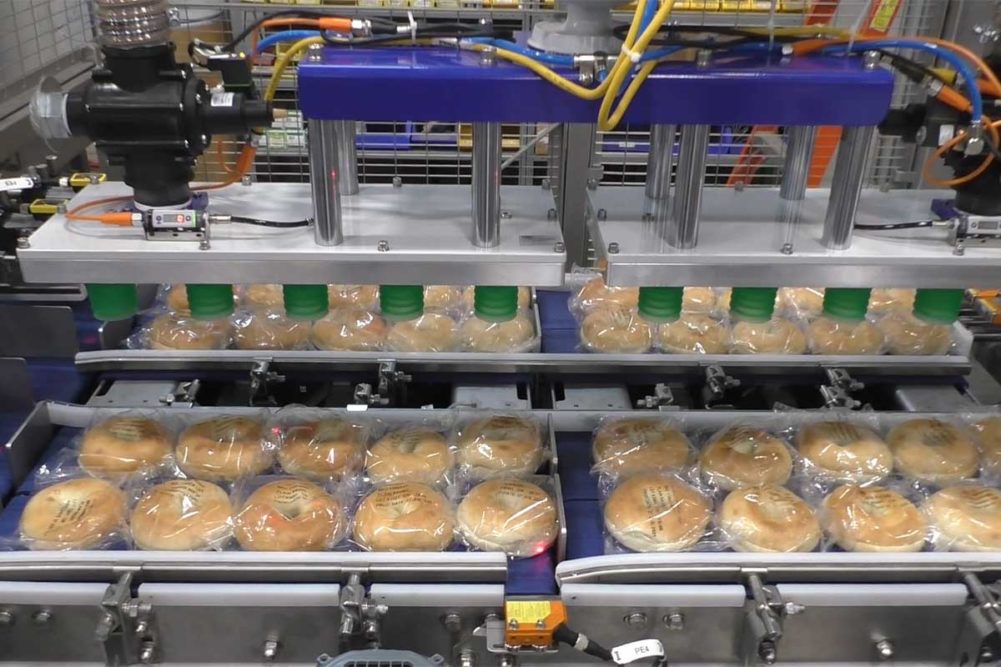Robotics have come a long way, but when it comes to packaging, a few persistent challenges remain, especially when it comes to handling delicate baked goods like croissants, pastries, muffins and artisan breads.
“Cost is one issue,” said Bill Kehrli, vice president of sales and marketing, Cavanna Packaging USA. “Wearing down and maintenance expense is another. Working out the kinks is a third because robotics involve a little more trial and error than exact science.”
With many fragile baked goods, he added, the challenge involves picking up the products and moving them to the flowwrapper or tray without damaging them. New end of arm technology (EOAT) can gently grasp items like a human hand, but the often rapid, back and forth movements of robotics can easily damage them.
“How do you hold onto products when a robot is accelerating and moving it at the speed you need on a high-speed line?” Mr. Kehrli asked. “How does it pick and move them when it’s doing 80 pieces a minute? That’s the challenge with those fingers.”
Jerry Buckley, south central sales manager, BluePrint Automation, pointed out that soft robotics-style gripper end effectors provide versatility for similar sized products, but these EOATs still have limitations. He suggested bakeries may need a “family” of end-effector grippers for a production line with a large range of product sizes.
“But note that these grippers are typically very quickly changed out, without the use of tools, within a matter of seconds,” he added.
Jamie Bobyk, marketing manager, Apex Motion Control, recommended the company’s Baker-Bot cobot, which safely works next to people without expensive protective caging.
“Often, you don’t even need to change end effectors when handling several different products,” he said. “For example, if you produce snack bars one shift and croissants the next shift, and even though the handling sensitivity for each product is slightly different, you could use the same end-effector. How? It comes down to recipes that are built into the touch screen tablet. Then it’s just a matter of pulling up and selecting the recipe that is associated with your product and away you go.”
For bakeries that require different EOATs to handle their products, tool changeover has become much simpler than in the past.
“A trained operator can remove one end effector and attach another in less than a minute,” noted Felix Pang, sales application specialist, ABI Ltd.
Alex Kuperman, chief executive officer, ABI Ltd., noted that such tools can be a challenge for some bakeries, but shifting from one product to another is getting easier.
“For untrained operators, [tool changeovers] can be a tedious task, which is why we designed an automated tool changeover feature,” Mr. Kuperman said. “In seconds, the robot stops its job, returns the end effector to the stand, securely attaches another EOAT, and starts the next job.”
Mr. Kehrli recommended giving all types of automation a close look before investing in top-of-the-line robotics.
“Don’t fall in love with technology,” he said. “We’ve seen more people go into robotics thinking they’re the solvable answer to everything, and they go back to hard automation three to five years later because robotics weren’t as efficient as they thought.”
With the workforce gap, a more user-friendly option might be just as good for some bakeries.
“You need a higher skill set to operate the robotics line than you would need on more conventional hard automation with belts, bar turning and that level of automation,” Mr. Kehrli said. “Many companies are exasperated today with our low skill sets and lack of labor. Typically, the individuals that can operate a robotics system will gravitate and get paid more by somebody else outside of the baking industry.”





